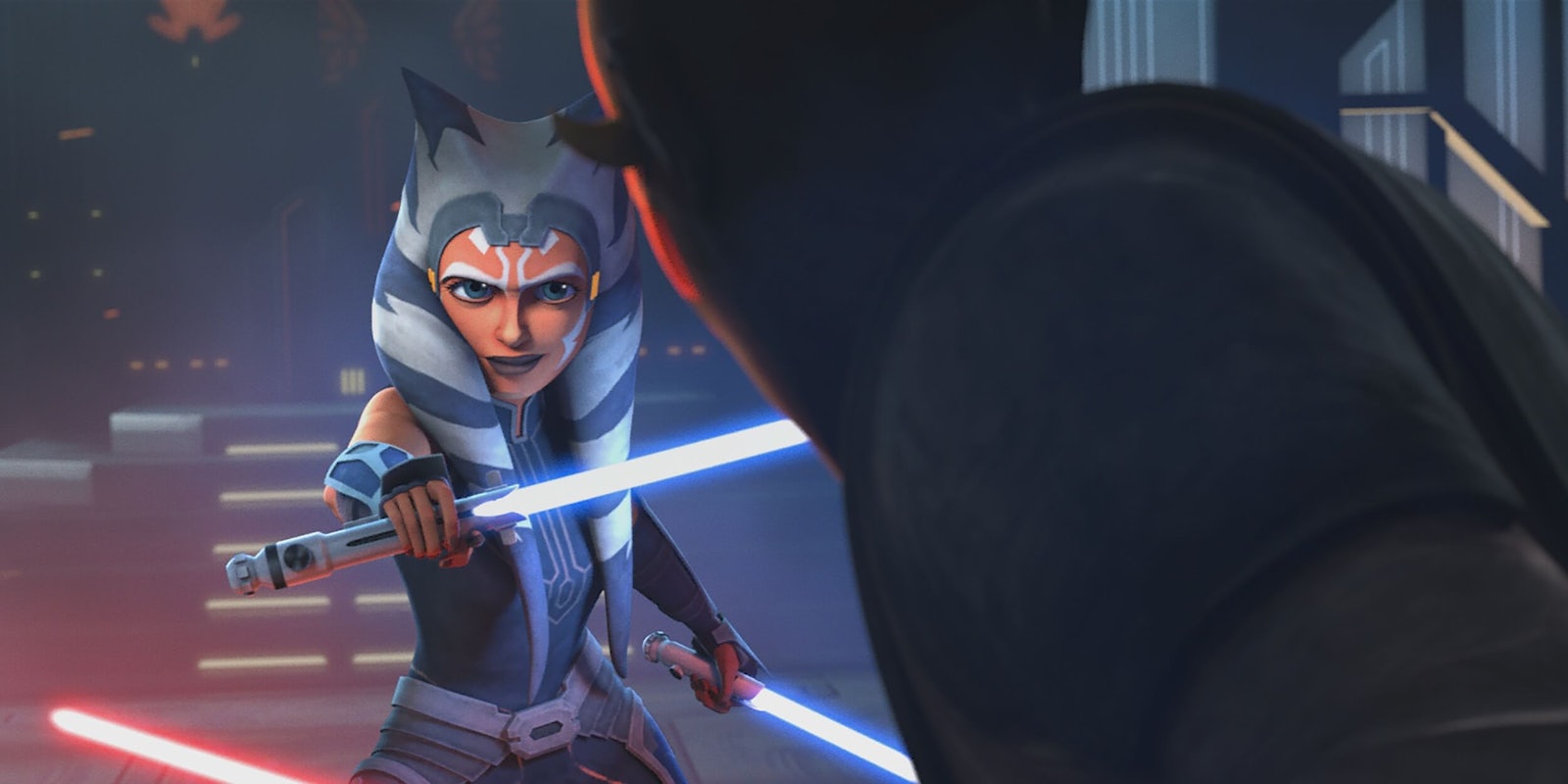This article contains spoilers.
In August 2008—more than three years after the theatrical release of Revenge of the Sith and seven years before The Force Awakens would help spawn a new generation of fans—Lucasfilm released a brand new Star Wars film in theaters. Titled Star Wars: The Clone Wars, it relayed an early conflict during the Clone Wars and gave Anakin Skywalker a padawan of his own to train. For longtime fans, it was somewhat familiar territory; a similarly named animated series, which ran from 2003 to 2005, already existed.
It’s not necessarily a good film (it’s currently the lowest-rated Star Wars film on Rotten Tomatoes), and in functionality, the Clone Wars movie operated more like a supersized pilot for a TV show—one that would run for seven seasons over the course of the next 12 years—more than a cohesive movie. Nevertheless, it was still an important entry in the Star Wars saga because it introduced us to the two characters who would eventually embody the heart and soul of The Clone Wars series: Ahsoka Tano (Ashley Eckstein), Anakin’s one-time padawan, and Rex (Dee Bradley Baker), the captain of the 501st Legion, the battalion that served under Anakin (and later Darth Vader).
This week, The Clone Wars series arrived at its end in a much different era than the one it came into. An improbable final season (one that fans had campaigned for years to get after The Clone Wars’ abrupt cancellation in 2013) debuted on a streaming service that didn’t exist during the show’s heyday. In the interim between cancellation and revival, the Star Wars franchise revitalized itself once again between five Star Wars films, two Disney animated series, and the first live-action Star Wars TV show, along with several comics, books, and video games; at least one film and three new shows are currently in development. Ahsoka Tano, who was initially written off by some fans as being too bratty or scoffed at the idea of having female characters front and center in a Star Wars story, is now one of Star Wars‘ most beloved characters.
It all wrapped up in a four-part arc about the long-fabled Siege of Mandalore and its aftermath, a fateful lightsaber duel between Ahsoka and Maul (voiced by Sam Witwer), and the execution of Order 66 from Ahsoka’s point of view. The final arc dropped on Disney+ over the course of 17 days, presented in an episodic format like the 129 episodes that came before it; the series finale premiered on Star Wars Day.
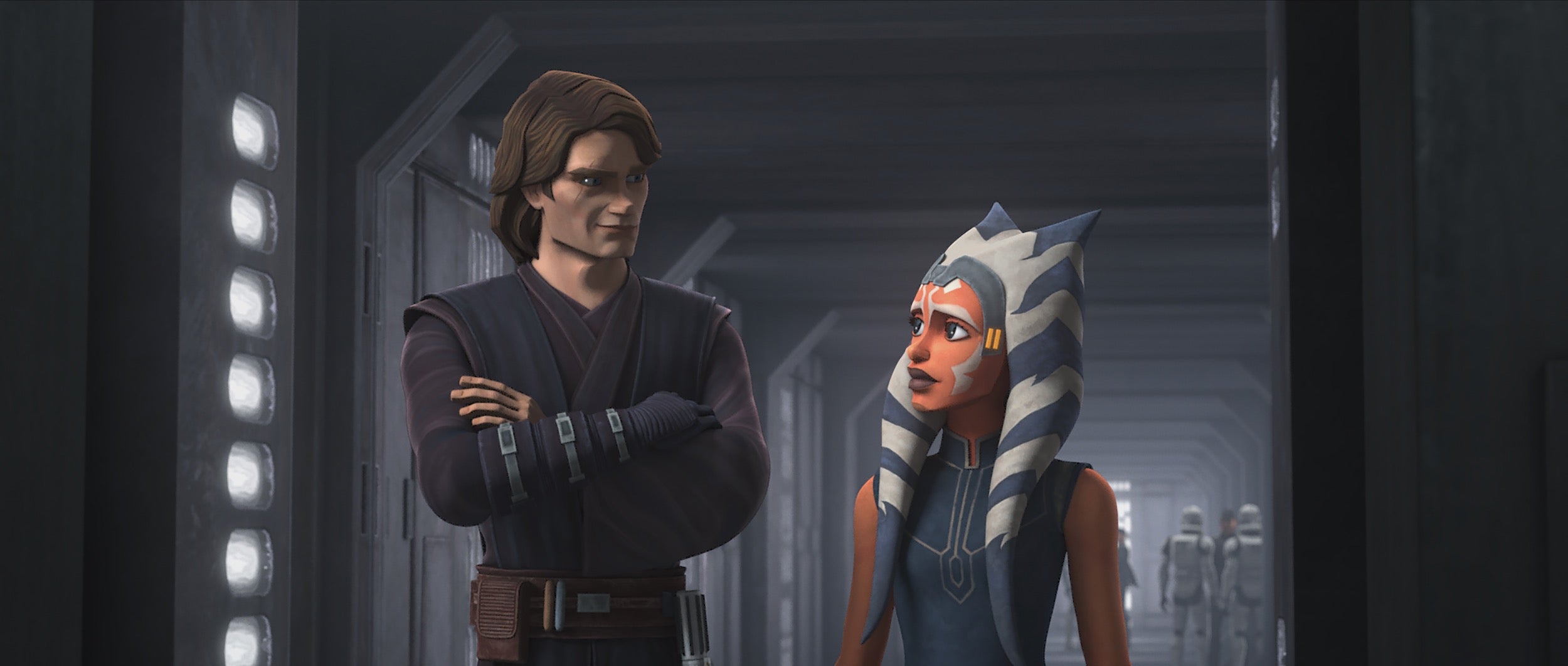
Even presented as in an episode format, the Clone Wars finale couldn’t feel more cinematic, an almost poetic mirroring of its start as a film that felt more like a stitched up TV show. At the top of Part 1 (“Old Friends Not Forgotten”), the original Lucasfilm Limited Production intro logo led to a red Clone Wars logo and the appearance of John Williams’ iconic score; Clone Wars is normally scored by Kevin Kiner. Gone is a quoted moral to lead into each episode, and after Part 1, Tom Kane’s trustworthy newsreel-esque narration disappeared entirely. The Clone Wars, thanks in part to a Disney+ budget, evolving animation technology, and an epic lightsaber battle assisted by motion-capture performances from Ray Park (the original Maul in The Phantom Menace) and Lauren Mary Kim, has never looked better.
One day, I hope Lucasfilm screens the Siege of Mandalore arc as a singular film somewhere like Star Wars Celebration or as a theatrical event when it’s safe to return to theaters. But it doesn’t really matter how you watch that final arc because it pulled off the near-impossible. It eschewed the prequel trap and delivered tension and believable stakes amid a series of set events. As much as it reveled in the spectacle and the occasional callback as part of a story much bigger than itself, the Clone Wars finale’s satisfying payoffs were always rooted in its central characters. And in doing so, it delivered a heartwrenching but fitting final benchmark of the Skywalker Saga.
…
I first started watching The Clone Wars a few years ago when it was still streaming on Netflix for a couple of reasons. While I always liked the films, I only really got into Star Wars after The Force Awakens and wanted to consume as much of that universe as I could. But there was also a lot of show to catch up on, so it seemed like the kind of thing I could watch as I knitted. And while I did plenty of that along the way, there were just as many times that I became engrossed enough in the story to put the needles down.
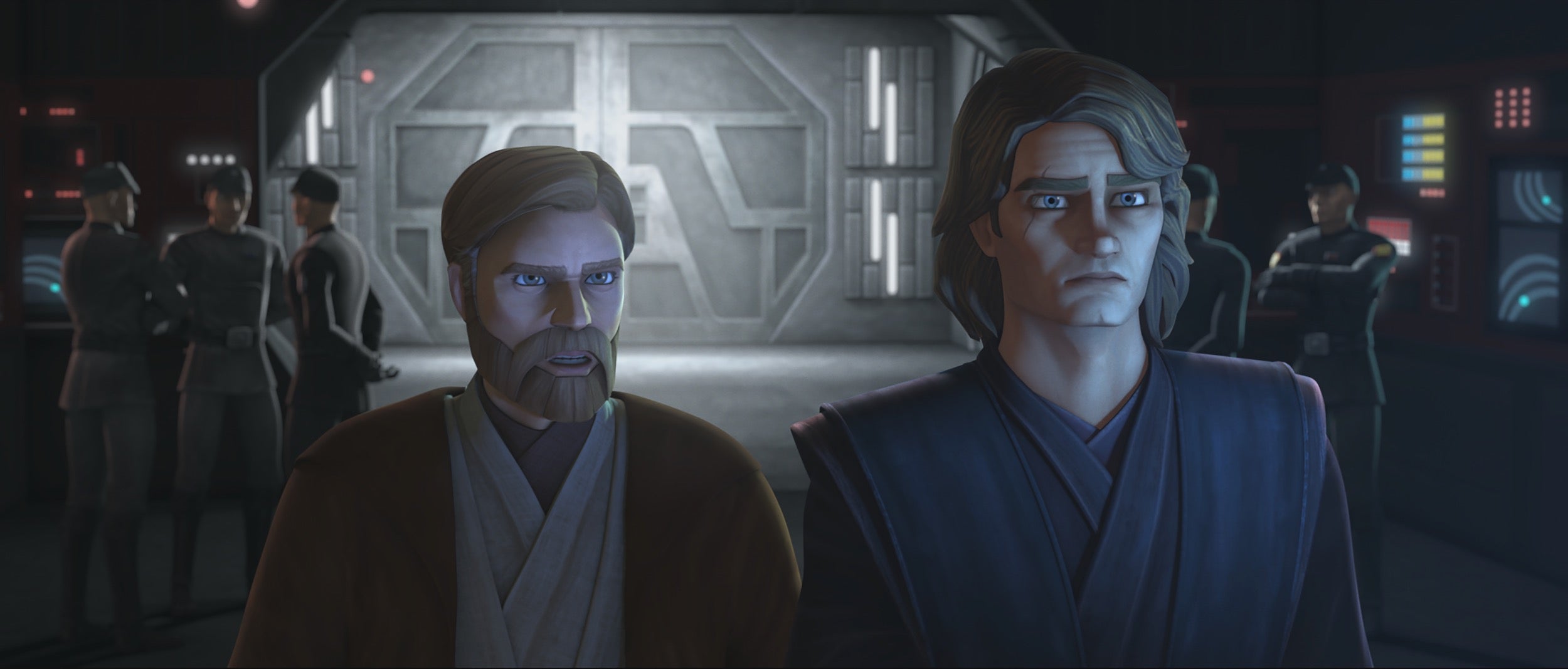
Created by George Lucas and with Dave Filoni (who worked on the first season of Avatar: The Last Airbender) on board as supervising director, The Clone Wars was, on the surface, a throughline between Attack of the Clones and Revenge of the Sith. But Clone Wars also gets to offer a more expansive look at the universe. It took a while for The Clone Wars to truly find its groove, but when it was good, it could stand with the best Star Wars stories.
It offered more nuance in Obi-Wan’s story and Anakin’s eventual fall (although Kiner couldn’t resist including Darth Vader’s “Imperial March” motif nearly every time Anakin did something even remotely sinister). It portrayed Jar Jar Binks as more than a one-note character and gave Padmé Amidala more agency before Revenge of the Sith took it away. In the hands of Baker, each clone had a distinctive voice, personality, and depths of humanity—a far cry from their eventual successors in countless uniform stormtroopers. It turned Maul, a character who basically just looked cool before The Clone Wars brought him back from the dead, into a tragic figure.
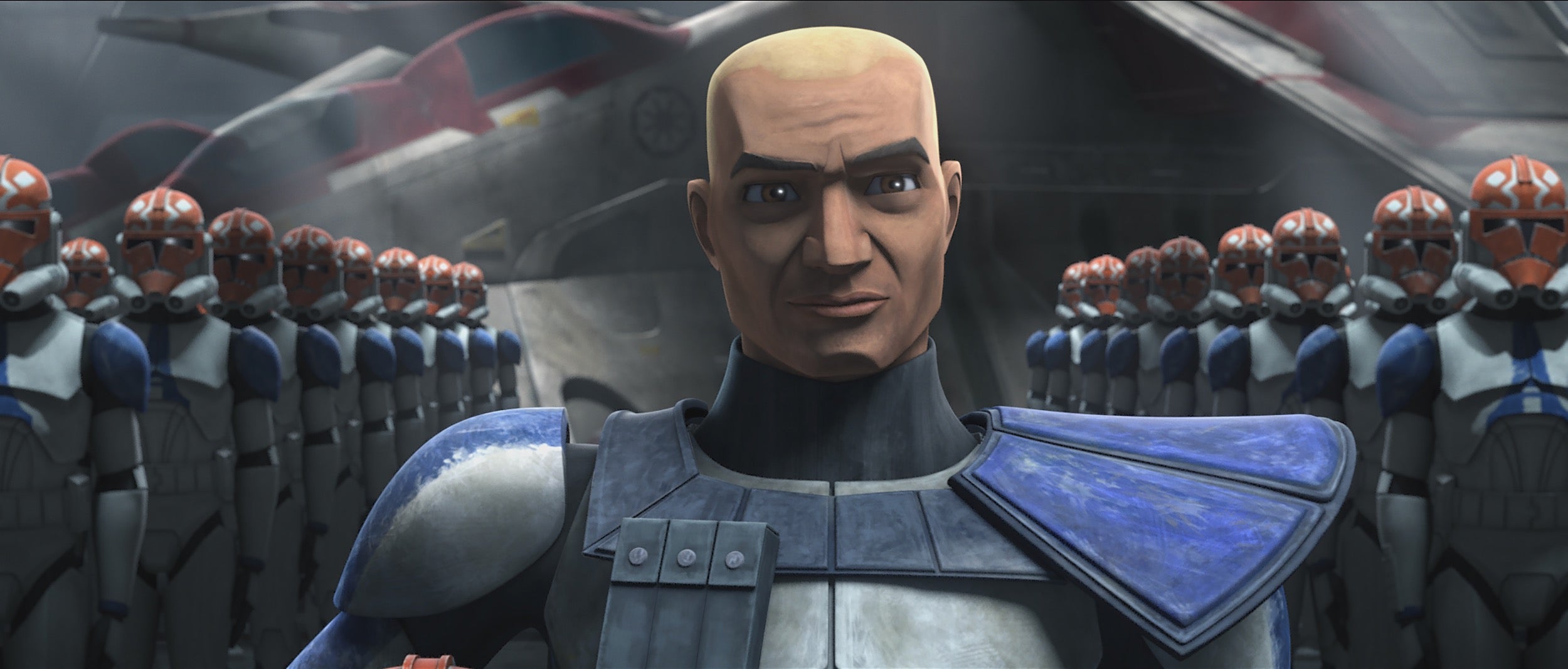
Ahsoka is the audience surrogate, and through her eyes, we were given a front-row seat to the inner orbit of Anakin and Obi-Wan. Ahsoka very much held her own against both Anakin and Obi-Wan; she was someone they could be proud of as she eventually grew beyond them. She pushed back, she was snippy and sarcastic, she had a good sense of humor and knew how to have fun, but above all else, she wanted to help people.
The Clone Wars had no intention of ending after Ahsoka left the Jedi Order in season 5, but then Disney canceled the series; a truncated sixth season eventually went to Netflix. While Filoni managed to reintroduce Ahsoka, Rex, and Maul back into the fold in Star Wars Rebels, apart from tie-in materials like E.K. Johnston’s Ahsoka, the unfinished reels, and occasional teases from Filoni, fans haven’t been able to get closure from The Clone Wars. Until now.
…
The nature of prequels is often both a blessing and a curse. You have preexisting material as an endpoint, but it makes it that much harder to tell a compelling story that does more than just fill in the blanks.
We’ve essentially known that The Clone Wars always ended in tragedy. Anakin always fell. Padmé always died while Luke and Leia always spent the first 19 years of their lives separated from the other. Obi-Wan and Yoda were always forced to go into hiding. Palpatine always took control of the galaxy, and, in effect, always used the clones to destroy the Jedi Order.
We eventually knew that Ahsoka and Rex—the two characters whose fates were the most up in the air at the start of the series—survived Order 66. And because he doesn’t die until he faces off against an older Obi-Wan in Rebels, Maul always survives, too. But it’s those three characters that hold the emotional crux of The Clone Wars’ final season regardless of knowing that their general fates are already sealed.
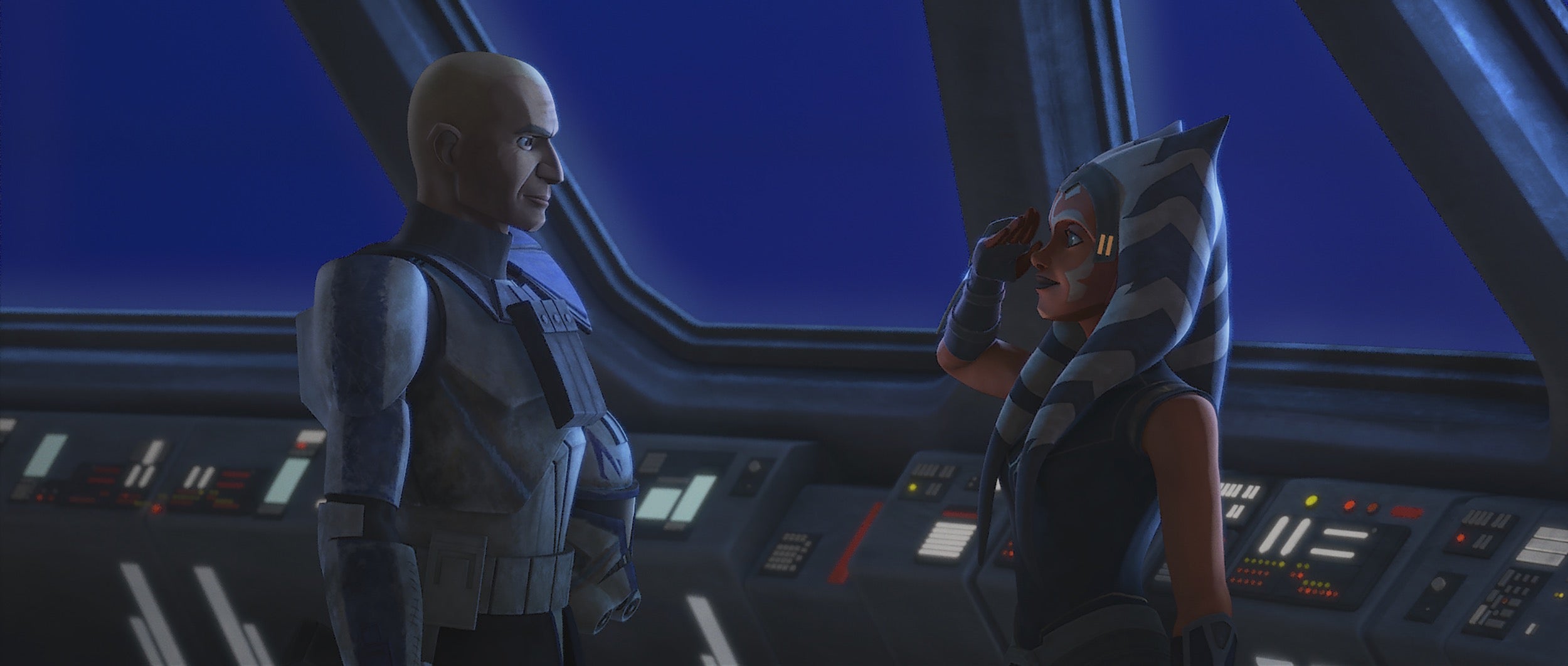
The first arc of season 7 focused in on Rex, his discovery that one of his brothers-in-arms wasn’t dead, and the cost of war through the eyes of the clones who only existed to fight in it, something that’s easy to forget when most of our time is spent among the Jedi and the Sith. The middle arc followed Ahsoka as she befriended and aided two sisters who had a less-than-glowing opinion on Jedi and their role in the galaxy. Even amid her own disillusion about the Jedi Order, Ahsoka is taken aback by how sheltered she’s been on how the public perceives the people she considered family.
Though some fans might’ve been left frustrated about waiting weeks to finally see the Siege of Mandalore, it was important for both Ahsoka and Rex to go on these journeys, which came to full fruition in an emotional conversation that takes place in The Clone Wars’ penultimate episode, titled “Shattered.”
Thanks to an earlier conversation with the Jedi Council, we knew where this moment takes place in relation to Revenge of the Sith. There was already a sense of dread present throughout the episode because we know what’s coming and the show knows we know what’s coming, but Ahsoka and Rex, whose loyalty to one another goes beyond words, have no idea. In what was their last moment of relative peace before the execution of Order 66, they reflected on their complicated feelings about the past few years.
“As a Jedi, we were trained to be keepers of the peace, not soldiers,” Ahsoka said. “But all I’ve been since I’ve been a padawan is a soldier.”
“Well, I’ve known no other way,” Rex replied. “Gives us clones all a mixed feeling about the war. Many people wish it’d never happened, but without it, we clones wouldn’t exist.”
At this point, we’re more than halfway through the final arc. We’ve seen the actual Siege of Mandalore, an operation proposed by Bo-Katan Kryze (Katee Sackoff) that would allow the Republic to capture Maul and allow Bo-Katan to wrestle Mandalore from Maul’s puppet leader. The Clone Wars indulged in fan service and Easter eggs from across the galaxy, ranging from a farewell between Anakin and Ahsoka that mirrored their bitter reunion years later to silent cameos from a young Caleb Dume and Crimson Dawn’s Dryden Vos and a small appearance from Sabine Wren’s mother Ursa. Every so often, we got Revenge of the Sith updates from Obi-Wan about Dooku’s death, or from Mace about General Grievous’ whereabouts.
The duel between Ahsoka and Maul surpassed expectations and echoed some of the visuals of The Last Jedi as Maul, powerless to stop Darth Sideous’ plot and Anakin’s turn, repeatedly asked Ahsoka for help. You can hear the sheer desperation in Witwer’s voice as he tried to convince Ahsoka to join him, but Ahsoka didn’t believe him. His intentions might’ve been nefarious, but in the end, Maul wasn’t wrong about Anakin.
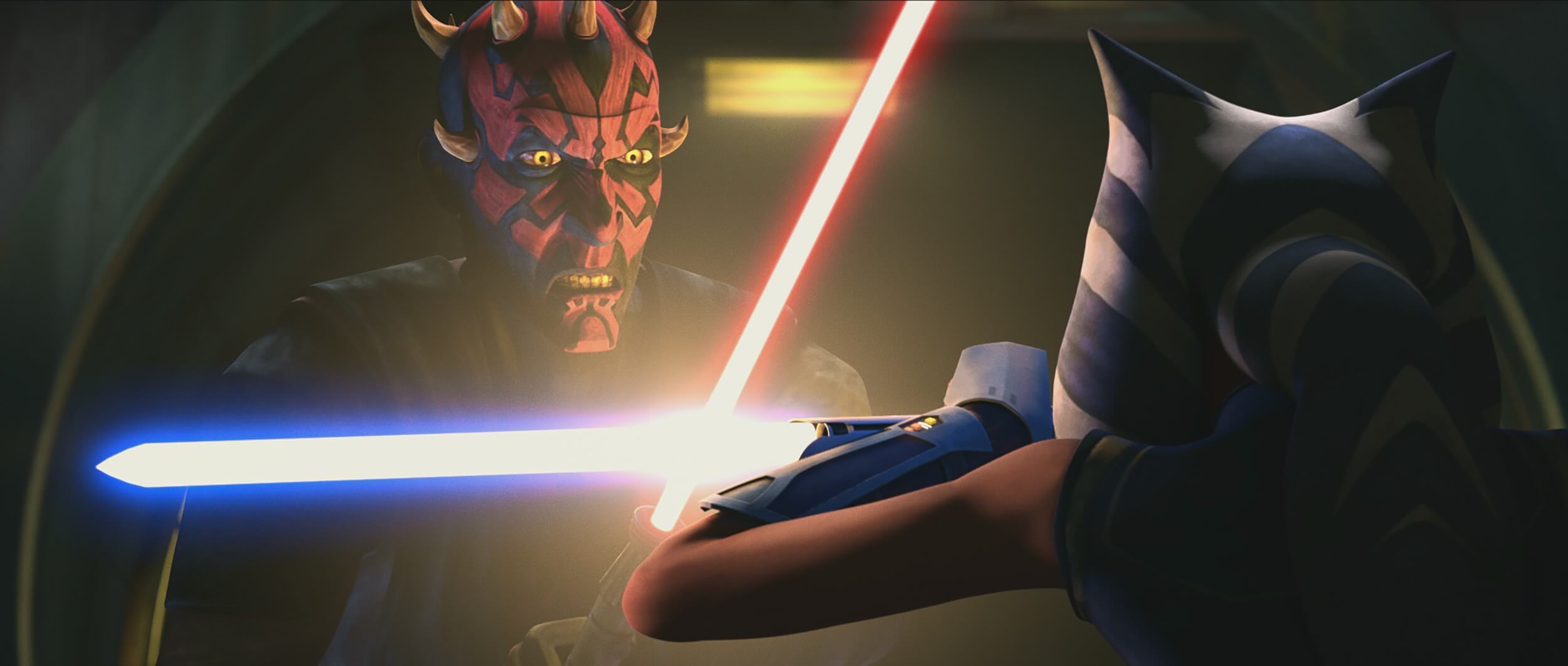
The finale was sentimental without getting too caught up in its own nostalgia, but it was also the kind of story that wouldn’t have worked or paid off years of character development without everything that came before it. Like the best kind of finales, it’s a story that happens through its characters, not to them. The Siege of Mandalore arc might not have answered every question we have, but enough of them were.
…
The final minutes of The Clone Wars play in near silence with only the occasional background noise and Kiner’s haunting score to carry it, elevating an already grand finale into something really special.

The star destroyer that Ahsoka and Rex were on crashed onto a nearby moon after Maul destroyed the hyperdrive, and while they survived by escaping on a Y-wing, the countless clones who spent their final moments trying to kill them did not; up until their end, Ahsoka refused to kill them herself. Ahsoka, now cloaked, looked on at the graves she and Rex dug for them and dropped one of her lightsabers before leaving her former life behind her.
Time passed. The moon is covered in snow as Imperial snowtroopers arrived with probe droids, and you can hear Darth Vader’s breathing before you catch a glimpse of him. But he never said a word: Instead, he picked up the lightsaber Ahsoka left and ignited it. After spotting a convor in the sky (a bird that’s long been associated with Ahsoka and the Force in Rebels), he turned it off and walked away as his reflection is framed in the helmet of a clone trooper that was once painted to honor his former apprentice.
It’s a moment where you almost expect Darth Vader to say something because, well, James Earl Jones has been game to reprise the role in recent years (Rebels, Rogue One, The Rise of Skywalker), and if you can get James Earl Jones to do Star Wars again, you do it. If The Clone Wars had indulged, it would’ve made sense. But it didn’t. It let the moment speak for itself and allowed Ahsoka and Rex’s grief to linger for just a little longer. It leaves us wondering just what is on his mind after finding one of the lightsabers he gave to Ahsoka not so long ago.

And it’s a reminder that for as much The Clone Wars was about actual war, it was always much more about the people caught in the middle who lost everything because of it. Even Darth Vader, who stands victorious as the Emperor’s righthand man amid a newly formed Galactic Empire, lost much more than we could’ve ever imagined.
READ MORE:

